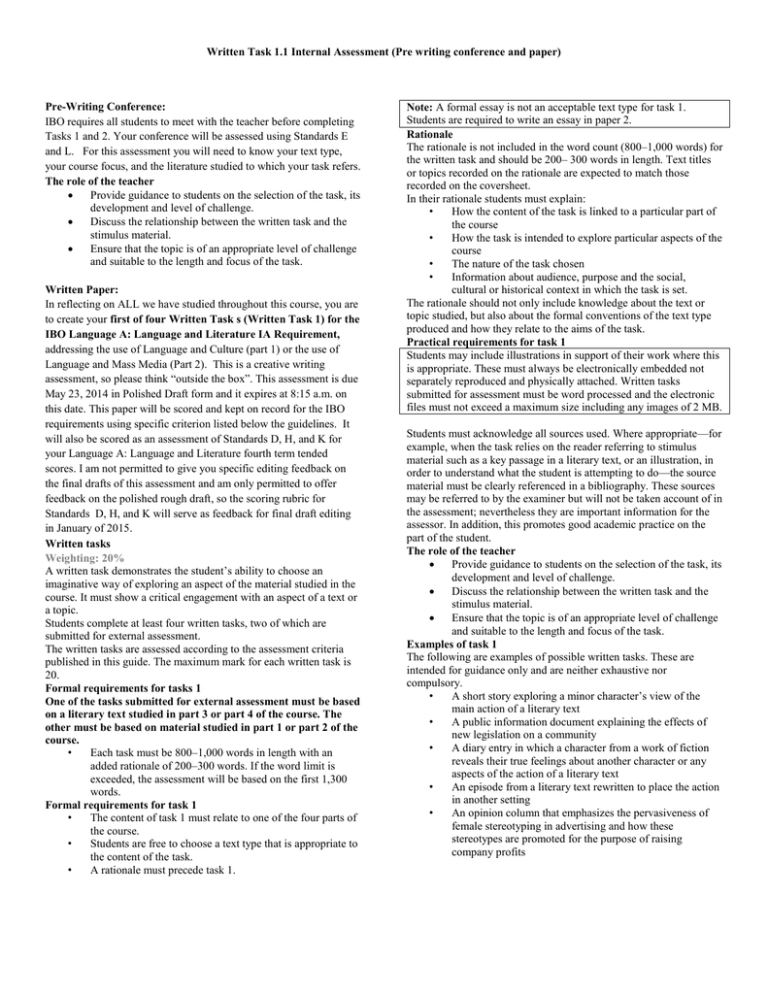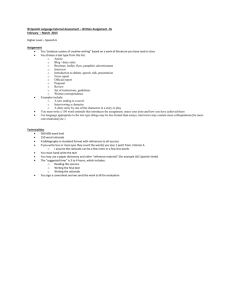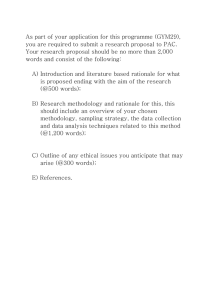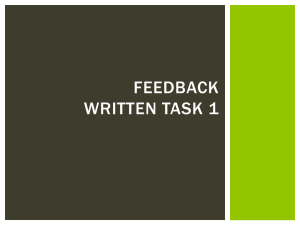Written Task 1.1 Internal Assessment (Pre writing conference and paper) Note:
advertisement

Written Task 1.1 Internal Assessment (Pre writing conference and paper) Pre-Writing Conference: IBO requires all students to meet with the teacher before completing Tasks 1 and 2. Your conference will be assessed using Standards E and L. For this assessment you will need to know your text type, your course focus, and the literature studied to which your task refers. The role of the teacher Provide guidance to students on the selection of the task, its development and level of challenge. Discuss the relationship between the written task and the stimulus material. Ensure that the topic is of an appropriate level of challenge and suitable to the length and focus of the task. Written Paper: In reflecting on ALL we have studied throughout this course, you are to create your first of four Written Task s (Written Task 1) for the IBO Language A: Language and Literature IA Requirement, addressing the use of Language and Culture (part 1) or the use of Language and Mass Media (Part 2). This is a creative writing assessment, so please think “outside the box”. This assessment is due May 23, 2014 in Polished Draft form and it expires at 8:15 a.m. on this date. This paper will be scored and kept on record for the IBO requirements using specific criterion listed below the guidelines. It will also be scored as an assessment of Standards D, H, and K for your Language A: Language and Literature fourth term tended scores. I am not permitted to give you specific editing feedback on the final drafts of this assessment and am only permitted to offer feedback on the polished rough draft, so the scoring rubric for Standards D, H, and K will serve as feedback for final draft editing in January of 2015. Written tasks Weighting: 20% A written task demonstrates the student’s ability to choose an imaginative way of exploring an aspect of the material studied in the course. It must show a critical engagement with an aspect of a text or a topic. Students complete at least four written tasks, two of which are submitted for external assessment. The written tasks are assessed according to the assessment criteria published in this guide. The maximum mark for each written task is 20. Formal requirements for tasks 1 One of the tasks submitted for external assessment must be based on a literary text studied in part 3 or part 4 of the course. The other must be based on material studied in part 1 or part 2 of the course. • Each task must be 800–1,000 words in length with an added rationale of 200–300 words. If the word limit is exceeded, the assessment will be based on the first 1,300 words. Formal requirements for task 1 • The content of task 1 must relate to one of the four parts of the course. • Students are free to choose a text type that is appropriate to the content of the task. • A rationale must precede task 1. Note: A formal essay is not an acceptable text type for task 1. Students are required to write an essay in paper 2. Rationale The rationale is not included in the word count (800–1,000 words) for the written task and should be 200– 300 words in length. Text titles or topics recorded on the rationale are expected to match those recorded on the coversheet. In their rationale students must explain: • How the content of the task is linked to a particular part of the course • How the task is intended to explore particular aspects of the course • The nature of the task chosen • Information about audience, purpose and the social, cultural or historical context in which the task is set. The rationale should not only include knowledge about the text or topic studied, but also about the formal conventions of the text type produced and how they relate to the aims of the task. Practical requirements for task 1 Students may include illustrations in support of their work where this is appropriate. These must always be electronically embedded not separately reproduced and physically attached. Written tasks submitted for assessment must be word processed and the electronic files must not exceed a maximum size including any images of 2 MB. Students must acknowledge all sources used. Where appropriate—for example, when the task relies on the reader referring to stimulus material such as a key passage in a literary text, or an illustration, in order to understand what the student is attempting to do—the source material must be clearly referenced in a bibliography. These sources may be referred to by the examiner but will not be taken account of in the assessment; nevertheless they are important information for the assessor. In addition, this promotes good academic practice on the part of the student. The role of the teacher Provide guidance to students on the selection of the task, its development and level of challenge. Discuss the relationship between the written task and the stimulus material. Ensure that the topic is of an appropriate level of challenge and suitable to the length and focus of the task. Examples of task 1 The following are examples of possible written tasks. These are intended for guidance only and are neither exhaustive nor compulsory. • A short story exploring a minor character’s view of the main action of a literary text • A public information document explaining the effects of new legislation on a community • A diary entry in which a character from a work of fiction reveals their true feelings about another character or any aspects of the action of a literary text • An episode from a literary text rewritten to place the action in another setting • An opinion column that emphasizes the pervasiveness of female stereotyping in advertising and how these stereotypes are promoted for the purpose of raising company profits E. I can demonstrate an ability to substantiate and justify ideas with relevant examples. Work demonstrates: a. Clear thesis or idea statement. b. Relevant use of justified support from text, research, experience, anecdote, etc. c. Use of relevant terminology/semantics. d. Use of relevant oral or written conventions of syntax. e. Logical organization of thoughts. f. Coherence within thought progression. g. Fluid use of English grammar and mechanical conventions. L. I can demonstrate a knowledge and understanding of correct and effective use of the English language in speaking. a. Knowledge and understanding of English grammar usage through non-repetitive errors. b. Knowledge and understanding of the use of tone when speaking. c. Knowledge and understanding of rate (speed) when speaking. d. Knowledge of voice usage, staying in appropriate person when addressing an audience through speech. e. Understanding of effective use of organization of thought and thought progression through use of transition words within speaking. f. Understanding of effective use of syntax within oral speaking through non-repetitive errors. g. Understanding of effective use of semantics (appropriate word choice for audience being addressed) within speaking. D. I can demonstrate an ability to recognize the importance of the contexts in which texts are written and received. Work demonstrates: a. Understand task/purpose. b. Understand various production types. c. Use of relevant terminology in respect to production type. d. Use of relevant conventions in respect to production type. e. Know and understand how production type chosen contributes to meaning. f. Understand chosen production type audience. g. Know and understand how the reception of texts contributes to meaning. H. I can demonstrate an ability to appreciate and use the oral and written forms of language, in a range of styles, registers, and situations. a. An appreciation of the different perspectives of people from other cultures. b. How these perspectives construct meaning in a range of styles, registers, and situations. c. An appreciation of the different text forms from other cultures. d. How these formats construct meaning in a range of styles, registers, and situations. e. An appreciation of formal, stylistic, and aesthetic qualities of text. f. A use of oral/written forms of language in a range of styles, registers, and situations. g. Ability to correctly cite textual support. K. I can demonstrate a knowledge and understanding of correct and effective use of the English language in writing. a. Knowledge and understanding of English grammar usage through non-repetitive errors. b. Knowledge and understanding of capitalization use through non-repetitive errors. c. Knowledge and understanding of punctuation use through non-repetitive errors. d. Knowledge of voice usage, staying in appropriate person when writing. e. Understanding of effective use of organization of thought and thought progression through use of transition words within a text. f. Understanding of effective use of syntax within a text through non-repetitive errors. g. Understanding of effective use of semantics within a text. Written task 1 (HL) Criterion A: Rationale Does the rationale for the written task explain how the task is linked to the aspects of the course being investigated? Note: The word length for the rationale is 200–300!words. If the word limit is exceeded, 1 mark will be deducted. Marks Level descriptor 0 The work does not reach a standard described by the descriptors below. 1 The rationale shows some explanation and understanding of the aspects being investigated. 2 The rationale shows clear explanation and understanding of the aspects being investigated. Criterion B: Task and content • To what extent does the task show understanding of the topic(s) or text(s) to which it refers? • How appropriate is the content to the task chosen? • To what extent does the task show understanding of the conventions of the text type chosen? A formal essay, such as that produced for paper 2, is not an appropriate text type for the written task. Submission of a formal essay will limit the marks available for this criterion. Marks Level descriptor 0 The work does not reach a standard described by the descriptors below. 1–2 The task shows a superficial understanding of the topic(s) or text(s) to which it refers. The content is generally inappropriate to the task chosen. The task shows a superficial understanding of the conventions of the text type chosen. 3–4 The task shows a mostly adequate understanding of the topic(s) or text(s) to which it refers. The content is generally appropriate to the task chosen. The task shows an adequate understanding of the conventions of the text type chosen 5–6 The task shows a good understanding of the topic(s) or text(s) to which it refers. The content is mostly appropriate to the task chosen. The task shows a good understanding of the conventions of the text type chosen. 7–8 The task shows an excellent understanding of the topic(s) or text(s) to which it refers. The content is consistently appropriate to the task chosen. The task shows an excellent understanding of the conventions of the text type chosen. Criterion C: Organization • How well organized is the task? • How coherent is the structure? Note: The word length for the written task is 800–1,000 words. If the word limit is exceeded, 2 marks will be deducted. Marks Level descriptor 0 The work does not reach a standard described by the descriptors below. 1 Little organization is apparent; the task has little structure. 2 Some organization is apparent; the task has some structure, although it is not sustained. 3 The task is organized; the structure is generally coherent. 4 The task is well organized; the structure is mostly coherent. 5 The task is effectively organized; the structure is coherent and effective. Criterion D: Language and style • How effective is the use of language and style? • How appropriate to the task is the choice of register and style? (“Register” refers, in this context, to the student’s use of elements such as vocabulary, tone, sentence structure and idiom appropriate to the task; register is assessed on the task itself.) Note: A student who writes an appropriate rationale but fails to achieve an appropriate register in the task cannot score more than 3 marks. Marks Level descriptor 0 The work does not reach a standard described by the descriptors below. 1 There is little clarity, with many basic errors; little sense of register and style. 2 There is some clarity, though grammar, spelling and sentence structure are often inaccurate; some sense of register, style and appropriate vocabulary. 3 The use of language and the style are generally clear and effective, though there are some inaccuracies in grammar, spelling and sentence construction; generally appropriate in register, style and vocabulary. 4 The use of language and the style are clear and effective, with a good degree of accuracy; sentence construction and vocabulary are varied, showing a growing maturity of style; the register is appropriate. 5 The use of language and the style are very clear and effective, with a very good degree of accuracy; sentence construction and vocabulary are good; the style is confident and the register effective.


